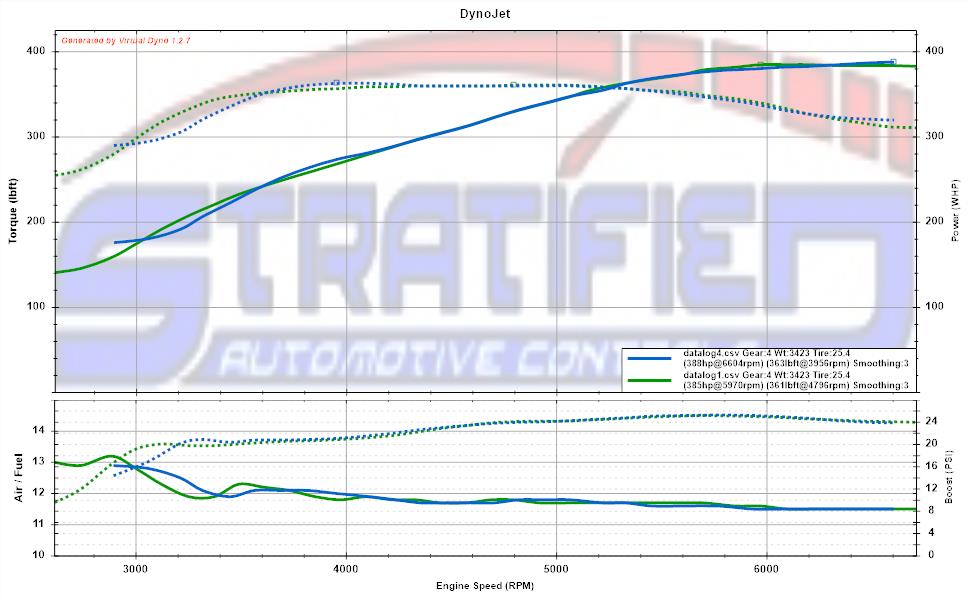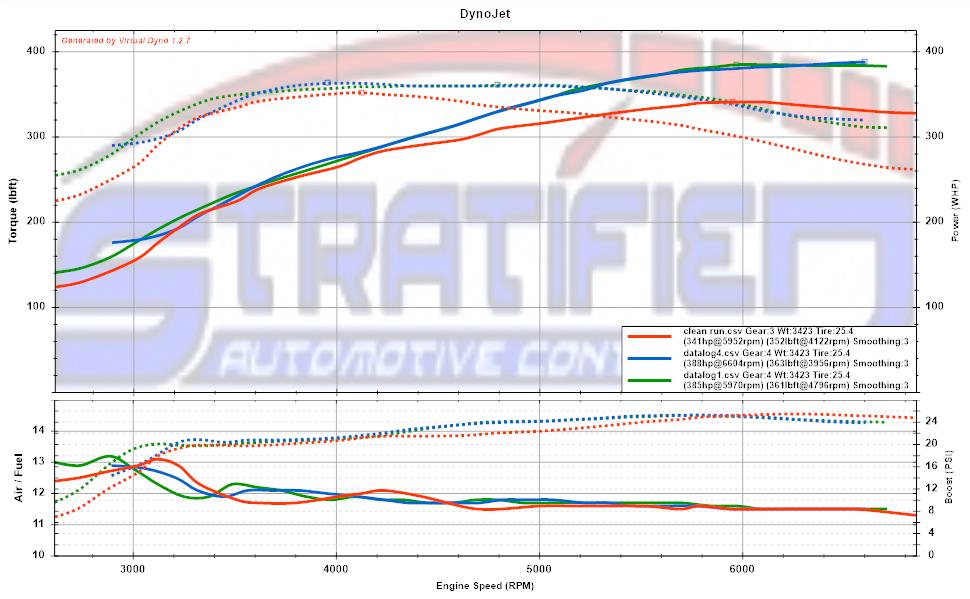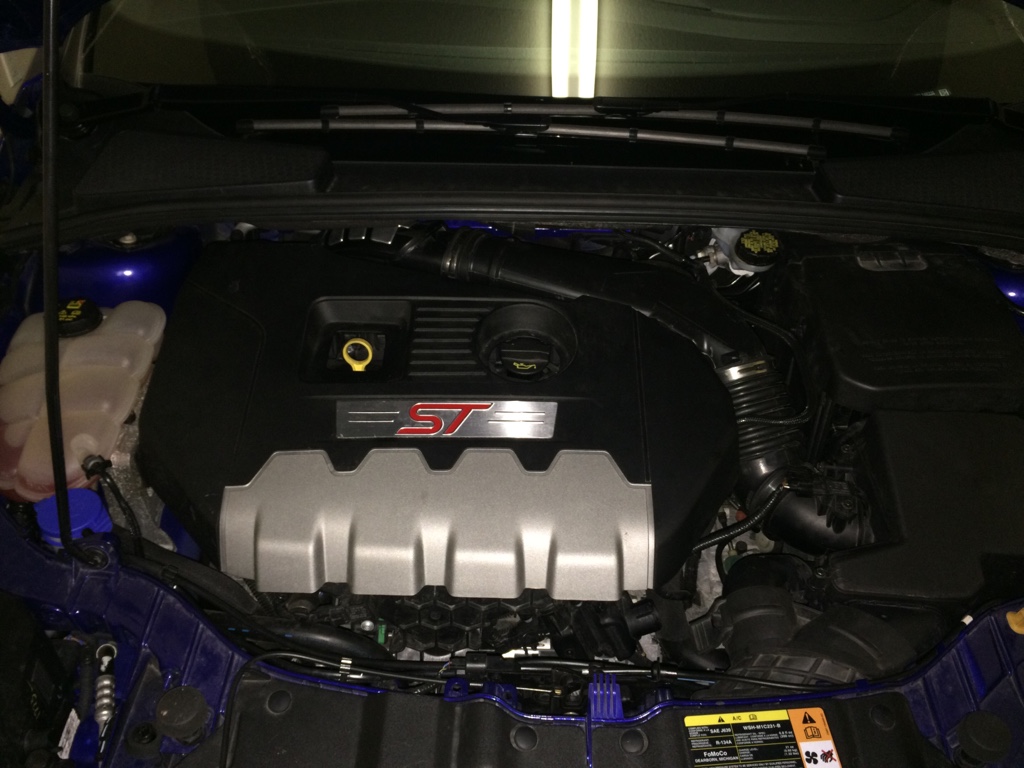Now that we’ve fully completed the installation and optimization of our Water Meth Injection (WMI) system we thought we’d share with you some of the details of the WMI install and tune on our shop Focus ST.
Below is a full list of the modifications we’ve installed so far:
ATP GTX2867 Bolt-on Turbo Kit 0.64 A/R
Catted COBB turbo-back exhaust
Tial Q BPV on CPE METHCharge cold side pipe
CPE Front Mount Intercooler
Stock intake and airbox with COBB filter
Coolingmist Auto-Learn WMI system, 7 Gal/Hr nozzle, 50/50 Water-Methanol mix
92 Octane base fuel
In stock form the biggest power output limitations in the car are airflow, fuel quality, and fuel volume delivered. The stock turbo was swapped out for a GTX2867r on our vehicle to address the airflow problem.
After this the OEM high pressure fuel pump (HPFP) starts to struggle past 360 ft-lbs of torque when using premium pump fuel. The octane limitation of pump fuel itself generally limits power output north of 350hp to the wheels on the 2.0 Ecoboost. To address the octane limitation and fuel pressure drops, the Coolingmist WMI system was used.
WMI has the following advantages:
– It cools down the air charge allowing more ignition timing advance.
– It provides very high octane alcohol (methanol) which increases the fuel octane. The additional alcohol fuel also takes some strain off the OEM fuel system.
– The WMI system helps keep the valves clean in direct injected engines
– The WMI system is only used when needed under high boost meaning the methanol tank won’t need to be constantly filled up.
Adding the WMI system provided around 10% additional fueling with the 7 Gal/Hr nozzle and 50/50 mix. We selected the Coolingmist Auto-learn system which has a built in failsafe. The failsafe system was able to detect our tank running dry as well as a leak that developed at one of the hose fittings.
You can see videos we took of the install here:
Part 1: Under the car
Part 2: Under the hood
Part 3: Inside the car
Results:
First of all, I should preface that we are very meticulous when taking Virtual Dyno logs to give results that are repeatable and therefore trustworthy. This is very important – you have to trust the data to be able to make sense of it.
The first graph below shows the finalized tune for WMI. The torque curve is very flat from 3000 RPM to redline and the car simply hauls.
Below is a comparison showing the gains we made by tuning the ECU to take advantage of the WMI system.
You can see how the top end benefited the most from the addition of WMI. We were able to safely add timing as well as increase the boost and at the same time keep the pistons nice and happy (no knock). This is what a proper power curve should look like on any car. Our Focus ST now has a flat torque curve with over 300 ft-lbs of torque available at the wheels, from 3,000 RPM right to redline. Notice how linear the horsepower curve is with the maximum power being right near redline.
Now, why no 400whp you ask? There are 2 parts of the car currently holding it back that last 10-15whp. The first is the stock intake which necks down quite a bit just before it joins the coupler on the GTX turbo inlet. The second is the catalytic converter on our COBB downpipe. At 400whp the catalytic converter is easily worth 15-20whp. With these two items swapped out we will be able to get more boost out of the turbo which will take it to 400+whp. The 385-390whp result you see above is done at only 25psi tapering down to 23.5psi. Given that the Focus is used as a daily driver the first upgrade will be the intake. For the intake the plan is to fabricate something that will fit nicely with the GTX turbo inlet. There is something to be said about the OEM intake that that is that you would never expect this engine bay to be that of a 390whp car.
Finally, I can’t stress enough how much fun it is to have a flat torque curve and perfectly straight horsepower curve. The car is extremely flexible and just doesn’t stop pulling to redline. With relatively minimal mods and a solid tune this little EcoBoost motor really does deliver. A WMI system is very much a worthwhile modification if you don’t have excellent pump fuel and want to move above 350whp on a big turbo. When purchasing a tune from us a WMI kit does not require and additional fuel map so long as you drive with it everyday.





